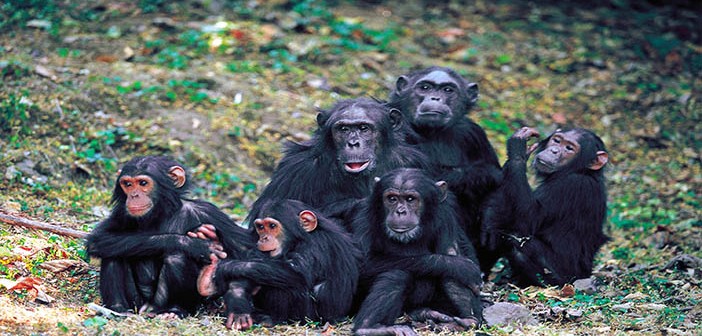After over 50 years of studying wild chimpanzees at Gombe National Park, Tanzania, as well as 20 years worth of research at JGI’s Tchimpounga Chimpanzee Rehabilitation Center in the Congo, scientists continue to discover new and exciting facts about our closest living relatives. In this recent science roundup, we share some of the more exciting discoveries from the past few months.
Low-Ranking Ladies Band Together at Gombe
Low-ranking female chimpanzees spend more time together thank other chimps.
Female chimps at the bottom of the social totem pole stick together more than their high-ranking peers, a new study from the Gombe Stream Research Center has found. Why these unrelated, low-ranking ladies spend so much time together is still up for debate, but researchers have some ideas.
While male chimpanzees socialize often with one another in the communities they were born into, female chimps live relatively solitary lives and are known to emigrate from their homes to new communities. Their most common companions are children and perhaps a sister or mother, but “new girls” that immigrate into a community usually do not have these familial bonds to rely on for support, protection and affection. Duke University’s Stephen Foerster and Anne Pusey proposed that low-ranking females at Gombe may band together to support one another against the aggression of high-ranking females who bully them. Pairing up could also mean pooling resources when it comes to sharing food or looking out for predators.
The study cannot yet say whether these “friends” actually like one another. The researchers plan to examine whether these relationships deteriorate with change, and signs of stable relations could indicate actual bonds of friendship rather than associations of necessity.
You can read more about the ongoing study on Duke Today.
http://today.duke.edu/2015/05/galpals
Chimps Could Cook if Given an Oven

Newly Discovered Chimpanzee Gene Resembles AIDS-Fighting Gene in Humans

Archived Chimp Vocalizations Just Released Reveal Chimps’ Wide Range of Sounds
 Chimpanzees have vast auditory means of communicating with one another, from loud pant-hoots of excitement to quiet laughs while playing. A study of over 10 hours of adult chimpanzee vocalizations collected in Gombe from 1971 to 1973 has recently been made available, covering chimps’ entire range of possible vocalizations. A breakdown of the 605 recordings shows a wide range of 41 call types observed in adults, from grunts and hoots to cries and sighs. The data package can serve as a useful tool for future studies on the evolution of human language. Those interested in knowing more about chimpanzee communication can use the long-term study of the same chimpanzees to examine their use of auditory signalling when referring to something, known as referential signalling. And future studies could also use the data to look into the emergence of dialects over time. The recently released data package accompanies a 2014 package of immature chimpanzee vocal recordings.
Chimpanzees have vast auditory means of communicating with one another, from loud pant-hoots of excitement to quiet laughs while playing. A study of over 10 hours of adult chimpanzee vocalizations collected in Gombe from 1971 to 1973 has recently been made available, covering chimps’ entire range of possible vocalizations. A breakdown of the 605 recordings shows a wide range of 41 call types observed in adults, from grunts and hoots to cries and sighs. The data package can serve as a useful tool for future studies on the evolution of human language. Those interested in knowing more about chimpanzee communication can use the long-term study of the same chimpanzees to examine their use of auditory signalling when referring to something, known as referential signalling. And future studies could also use the data to look into the emergence of dialects over time. The recently released data package accompanies a 2014 package of immature chimpanzee vocal recordings.



